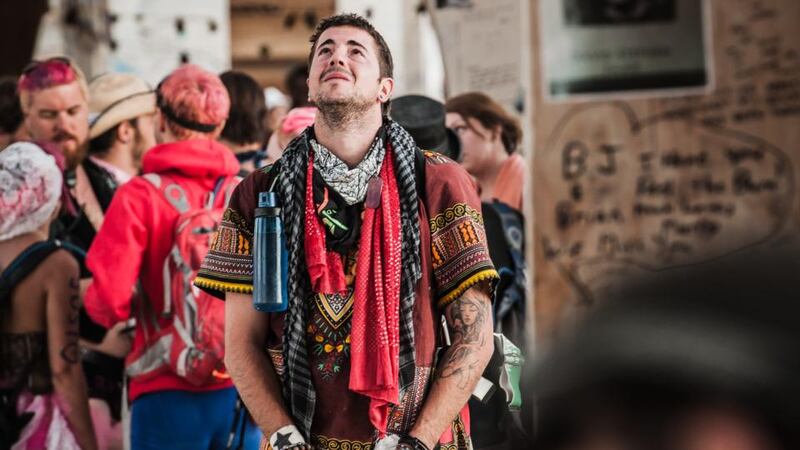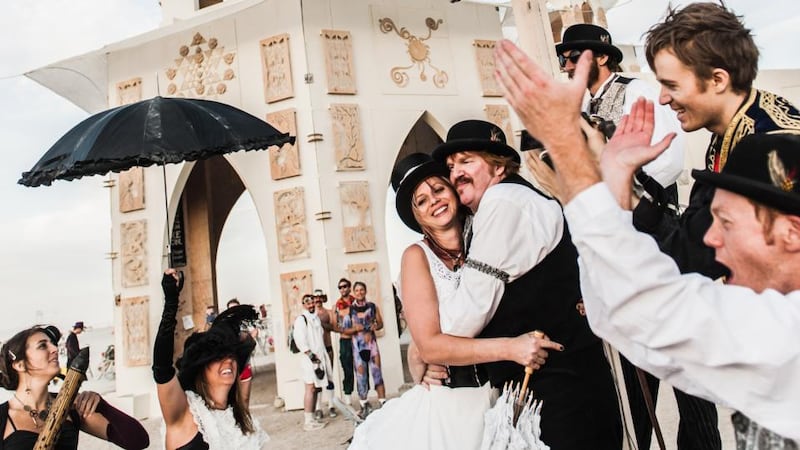Irish photographer Peter Gordon first experienced the infamous Burning Man Festival 12 years ago. At the age of 20 he went to the event in the Nevada desert with a bunch of college friends, all of whom were working and partying hard on the US west coast, courtesy of the J1 visa. His experience of the festival (“dedicated to community, art, self-expression and self-reliance”, according to its website burningman.com) was, he recalls “a completely different thing. I had arrived off the back of a pretty wild summer in San Francisco, and the experience blew me away.” While there (in moments of occasional lucidity, no doubt) Peter became aware of the festival’s fundamental focus – the Temple of Transition, by name and nature a temporary structure that acts as the hub for audience engagement. “There are people having very genuine spiritual experiences at the Temple,” he explains, “and there’s a real openness about grief, marriage, and so on. The climax of the festival sees the Temple being burnt, and with it the grief that people have shared within its walls. What became clear to me very quickly was that the Temple was a lot more than a structure; it was a non-judgmental environment allowing people to have a cathartic experience that in many cases set them free.” His visa having expired, Peter returned to Ireland to focus on his academic studies, but after bagging a degree in history and politics, and a master’s in international relations, he decided – not at all on a whim – he wanted to be a photographer. For this we can blame his father Ed and the latter’s photography business, ExploreLight (explorelight.com), which since 2006 they have operated together).
“When I was a kid he put me off it,” Peter says of the snap-happy relationship between father and son, “because he would make me carry his bags at strange hours of the day, like sunrise. When I started to travel, however, I began to take photographs. Certain things I would see fascinated me, but the images I took didn’t capture that fascination, or give the same emotional response as I felt when I saw them. From that point, I started to hound him for information, to start learning from him.”
Peter proved to have as sharp an eye for detail as his father, and since he joined the family business ExploreLight has focused more on creative projects. Their newest art project, their most ambitious and alternative to date, is Life and Death – The Temple, an impressive coffee table art book with 70 evocative images of Peter's second Burning Man experience.


Invited by Diarmaid Horkan of International Arts Megacrew, an installation art team that researches and competes for public art commissions, Peter travelled to the Nevada desert in the summer of 2011. With 10 years of adult life experience behind him since his first visit – including marriage and two children – he was struck as much by the potential for striking imagery as by the festival’s spiritual aspects.
According to Peter, the Temple is both art installation and therapy. “Yes, the idea is that it is a piece of art, but after my first visit 12 years ago I knew I wanted to capture not just the structure of the Temple but also to tell a human story about significant spiritual experiences. Art does that, poetry and music do that. Of course, the project also brings in the documentation of the art and a sharing of that process through imagery, but it’s very much art, no question about it.”
What kind of person attends such an event? “It’s ridiculous to say it’s just hippies that go,” Peter insists. “My impression is that large swathes of people at it are actually middle-class Californians, well educated, with jobs in IT and financial services. There is certainly a very alternative crowd of people that go there, for sure, but there is a spectrum. And the hippie thing is really not the case, as there’s a sharpness and pragmatism to people in how they interact.”
As a working photographer amid the desert storms and swirls of people attending for various reasons, what were the positives and negatives? He says the positives included the concept of the work project, which enabled him to produce something that had never been done before. “Beyond the conceptual framework, it’s just really pretty – the structure of the building, the light you get in the desert, the dust storms that roll through, and the graphic shapes they create.” The negatives? “It’s quite a harsh environment. It’s a very awkward place to get into and out of – you’re queuing for up to eight hours in your car, which is a bit of a nightmare. And it’s a difficult place to take pictures, as cameras don’t like dust storms. That was tricky!”
Life and Death – The Temple, by Peter Gordon, is published by ExploreLight Publishing. The titular exhibition opens next Thursday, October 24th, and runs until November 3rd, at the Centre for Creative Practices, 15 Pembroke Street Lower, Dublin 2.





